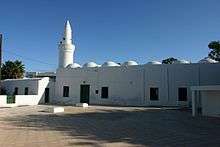Turks in Tunisia
The Turks in Tunisia, also known as Turco-Tunisians[3] and Tunisian Turks,[4] (Arabic: أتراك تونس; French: Turcs de Tunisie; Turkish: Tunus Türkleri) are ethnic Turks who constitute one of the minority groups in Tunisia.[5]
| Total population | |
|---|---|
| 500,000[1]–2,000,000[2] | |
| Regions with significant populations | |
| Languages | |
| Religion | |
| Sunni Islam |
In 1534, with about 10,000 Turkish soldiers, the Ottoman Empire took control and settled in the region when Tunisia's inhabitants called for help due to fears that the Spanish would invade the country.[6] Thus, during the Ottoman rule, the Turkish community dominated the political life of the region for centuries; as a result, the ethnic mix of Tunisia changed considerably with the continuous migration of Turks from Anatolia, as well as other parts of the Ottoman territories, for over 300 years. In addition, some Turks intermarried with the local population and their male offspring were called "Kouloughlis".[7][8][9] Consequently, the terms "Turks" and "Kouloughlis" have traditionally been used to distinguish between those of full and partial Turkish ancestry.[10]
In northern Cap Bon, the town of Hammam Ghezèze (lit. "Oghuz's bath") is populated with descendants of Oghuz Turks (Ghezèze and Aghzaz being Arabic for "Oghuz").
Demographics
Families of Turkish origin live mainly near the coastal cities, such as Tunis, Mahdia, Hammamet and the islands (such as Djerba), although there are also many living within central Tunisia as well.[11][12]
Culture
Language
In 2012 the Tunisian government introduced the Turkish language in all Tunisian secondary schools.[13]
Religion
The Ottoman Turks brought with them the teaching of the Hanafi School of Islam during the Ottoman rule of Tunisia, which still survives among the Turkish-descended families today.[14] Traditionally, Turco-Tunisian mosques have octagonal minarets.[14] Examples of Ottoman-Turkish mosques include:
Notable people
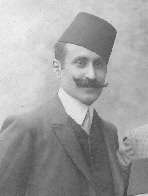
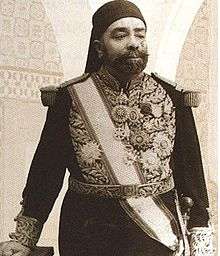

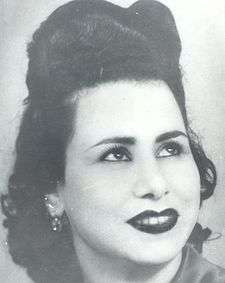
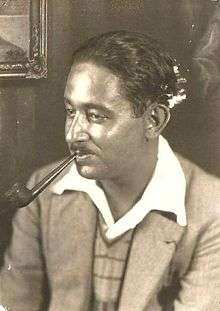
The Turks in Tunisia were traditionally a privileged élite in Tunisia who held positions in the military and the bureaucracy.[15] However, by the nineteenth century, marriages with the local population linked the ruling families to indigenous notables. At this time, many Turks also turned to commerce and the crafts, initially in the Souq el-Trouk (the Bazaar of the Turks), where a considerable number of merchants of Turkish ancestry emerged. The Turks also entered the corps of artisans.[15] The Ben Romdhan family, of Turkish origin, claim much of the notable Tunisian families of Mahdia such as the Hamza, Turki, Gazdagli, Agha, and Snène families.[16] Other prominent Tunisian families of Turkish origin include the Bayrams, Belkhodjas, El Materis, Sfars, Osmans, Mamis and the Slims.
- Ahmed Abdelkefi, economist[17]
- Hassan Hosni Abdelwaheb, historian
- Mahmoud Aslan, writer[18]
- Saloua Tarzi Ben Attia, politician
- Al-Husayn I ibn Ali at-Turki, founder of the Husainid Dynasty[19]
- Mohamed Salah Baratli, resistant of the French occupation, opponent of President Bourguiba, human rights activist
- Ahmed Bayram, religious cleric
- M'hammed Bayram, religious cleric
- Mohamed Bayram V, intellectual
- Mohamed Taieb Bayram, religious cleric
- Ahmed Belkhodja, religious cleric[20]
- Asma Belkhodja, pioneer of the Tunisian feminist movement[21]
- M'hammed Belkhodja, politician[22]
- Ali Bach Hamba, journalist and politician[23]
- Mohamed Bach Hamba, writer[24]
- Mahmoud Ben Mahmoud, filmmaker[25]
- Yasemin Besson, wife of Éric Besson[26]
- Lotfi Bouchnak, musician[27]
- Hassen Bouhajeb, doctor[28]
- Mahmoud Bourguiba, journalist
- Ahmed Chérif, doctor[28]
- Béchir Dinguizli, doctor[28]
- Mustapha Dinguizli, politician[29]
- Ali Douagi, literary and cultural icon[30][31]
- Abderrahman Dziri, medical researcher[32]
- Mustafa Elkatipzade, Fenerbahçe football manager
- Nazli Fadhel, pioneer of the Tunisian feminist movement[33]
- Sadok Ghileb, politician[34]
- Fadhila Khetmi, theatre director
- Afef Jnifen, model and actress[35]
- Mohamed Lahbib, pioneer of theater and television in Tunisia[36]
- Mahmoud El Materi, physician and politician[37]
- Moncef El Materi, former soldier and businessman[37]
- Sakher El Materi, businessman[37]
- Tahar El Materi, businessman[37]
- Habib Osman, photographer
- Mustapha Osman, artist
- Chafia Rochdi, singer and actress[38][39]
- Hichem Rostom, actor[40]
- Mourad Salem, artist[41]
- Rachid Sfar, former prime minister[42]
- Mongi Slim, nationalist leader and Minister[43]
- Mustapha Kamel Tarzi, diplomat
- Najiya Thamir, writer and radio producer[44][45]
- Hedi Turki, painter[4][46]
- Yahia Turki, painter[47]
- Zoubeir Turki, painter[48]
- Abdeljelil Zaouche, Minister of Justice (1936–1943)[28]
- Sadok Zmerli, professor[22]
See also
- Kouloughlis
- History of Ottoman-era Tunisia
- Tunisia-Turkey relations
- Turkish minorities in the former Ottoman Empire
References
- Akar, Metin (1993), "Fas Arapçasında Osmanlı Türkçesinden Alınmış Kelimeler", Türklük Araştırmaları Dergisi, 7: 94–95,
Günümüzde, Arap dünyasında hâlâ Türk asıllı aileler mevcuttur. Bunların nüfusu Irak'ta 2 milyon, Suriye'de 3.5 milyon, Mısır'da 1.5, Cezayir'de 1 milyon, Tunus'ta 500 bin, Suudî Arabistan'da 150 bin, Libya'da 50 bin, Ürdün'de 60 bin olmak üzere 8.760.000 civarındadır. Bu ailelerin varlığı da Arap lehçelerindeki Türkçe ödünçleşmeleri belki artırmış olabilir.
- Sertoglu, Sedat (1998), Haftaya Bakış, 7, Bakış Basın Yayın Organizasyon, p. 35,
Bugün Tunus'ta Türk kökenli 2 milyon insan yaşadığı bildirilmekte ve Dunlardan 60-70 yaşın üzerindekiler Türkçe bilmektedirler.
. - Hourani & Ruthven 2002, 129.
- Today's Zaman. "Turks in northern Africa yearn for Ottoman ancestors". Archived from the original on 2011-03-13. Retrieved 2012-03-18.
- UNESCO 2009, 9.
- UNESCO 2009, 12.
- Tunisia Today. "Vient de paraître "Tribus : des origines à la dislocation"". Retrieved 2012-04-18.
- UNESCO 2009, 13.
- Milli Gazete. "Levanten Türkler". Archived from the original on 2010-02-23. Retrieved 2012-03-19.
- Miltoun, Francis (1985), The spell of Algeria and Tunisia, Darf Publishers, p. 129, ISBN 1850770603,
Throughout North Africa, from Oran to Tunis, one encounters everywhere, in the town as in the country, the distinct traits which mark the seven races which make up the native population: the Moors, the Berbers, the Arabs, the Negreos, the Jews, the Turks and the Kouloughlis… descendants of Turks and Arab women.
- Leaders. "Le Monde Arabe et la Turquie: les prémices d'une entente". Retrieved 2013-03-29.
- Delarosbil, Dave (2006), Mahdia : histoire et société (PDF), Université de Montréal, p. 7
- Benrabah, Mohamed (2013), Language Conflict in Algeria: From Colonialism to Post-Independence, Multilingual Matters, p. 186, ISBN 1847699669
- Jacobs & Morris 2002, 460.
- Green 1978, 47.
- Khouaja 1962, 89.
- Tunisia Today. "Ahmed Abdelkefi, la machine à idées!". Retrieved 2012-04-18.
- Déjeux 1984, 269.
- Brett & Fentress 1997, 178.
- Smida 1971, 340.
- Union Nationale de la Femme Tunisienne. "Asma Belkhodja-Rébaï, une pionnière du mouvement féministe tunisien (1930-2011)". Archived from the original on 2014-02-03. Retrieved 2013-03-29.
- Africa Time. "Histoire et repères: Grandes figures tunisiennes". Retrieved 2013-04-04.
- Puaux 1954, 16.
- Derrick 2008, 52.
- Toute la Tunisie. "Mahmoud Ben Mahmoud". Archived from the original on 2013-11-03. Retrieved 2012-04-17.
- Hurriyet. "Umarım yakında bütün Arap kadınları Tunuslularla aynı haklara sahip olur". Retrieved 2013-03-24.
- Last FM. "Lotfi Bouchnak". Retrieved 2012-04-17.
- Ferté & Barrera 2010, 252.
- Paul Lambert, Dictionnaire illustré de La Tunisie : choses et gens de Tunisie, éd. C. Saliba aîné, Tunis, 1912, p. 157
- Granara 2010, 79.
- Toute la Tunisie. "Ali Douagi". Archived from the original on 2012-07-17. Retrieved 2012-04-17.
- Leaders. "Abderrahman Dziri". Retrieved 2013-03-29.
- Leaders. "La princesse Nazli Fadhel en Tunisie: une figure moderniste". Retrieved 2013-03-29.
- Mohamed El Aziz Ben Achour, Catégories de la société tunisoise dans la deuxième moitié du XIXe siècle, éd. Institut national d'archéologie et d'art, Tunis, 1989, p. 235
- Sanna, Cristiano (2019). "[Il ritratto] Afef, le quarte nozze, i milioni e quei veleni da scansare. Il potere riservato di una ribelle". Tiscali Spettacoli. Retrieved 26 September 2019.
- Africa Time. "Les pionniers du théâtre et de la TV en Tunisie-Mohamed Lahbib : le kawkeb du théâtre arabe en Tunisie". Retrieved 2013-03-27.
- TelQuel. "TUNISIE. Où s'arrêtera Sakhr El Materi?". Archived from the original on 2013-05-10. Retrieved 2013-03-27.
- Ferchiou 2001, 305.
- Africa Time. "Chafia Rochdy : la voix cristalline venue du Sud". Retrieved 2013-03-27.
- Festival Tetouan. "Hommages 2012: Hichem Rostom , Acteur Tunisien". Archived from the original on 2012-05-02. Retrieved 2012-04-18.
- Royal Borough of Kensington and Chelsea. "Sultans Are No Sultans: Mourad Salem". Retrieved 2013-10-13.
- Rachid Sfar. "Le LEADERS TAHAR SFAR CO-FONDATEUR AVEC BOURGUIBA DU PARTI TUNISIEN NEO-DESTOUR FUT DE 1925 à 1928 UN ETUDIANT EXCEPTIONNEL". Retrieved 2014-06-07.
- Bidwell 2012, 388.
- Arab Women Writers. "Najiya Thamir". Retrieved 2012-04-17.
- Women of Tunisia. "Tunisian women Yesterday and Today: Nejia Thameur". Retrieved 2012-04-17.
- Toute la Tunisie. "Hédi Turki". Archived from the original on 2013-07-27. Retrieved 2012-04-17.
- Toute la Tunisie. "Yahia Ben Mahmoud El Hajjem Turki". Archived from the original on 2012-07-16. Retrieved 2012-04-17.
- Toute la Tunisie. "Zoubeïr Turki". Retrieved 2012-04-17.
Bibliography
- Abun-Nasr, Jamil M. (1982), "The Tunisian state in the eighteenth century", Revue de l'Occident musulman et de la Méditerranée, 33 (0): 33–66
- Akar, Metin (1993), "Fas Arapçasında Osmanlı Türkçesinden Alınmış Kelimeler", Türklük Araştırmaları Dergisi, 7: 91–110
- Bidwell, Robin (2012), Dictionary Of Modern Arab History, Routledge, ISBN 1136162984.
- Brett, Michael; Fentress, Elizabeth (1997), The Berbers, Wiley-Blackwell, ISBN 0631207678.
- Brunschvig, Robert (1965), "Justice religieuse et justice laïque dans la Tunisie des Deys et des Beys: jusqu'au milieu du XIXesiècle", Studia Islamica, Maisonneuve & Larose, 23 (0): 27–70
- Déjeux, Jean (1984), Dictionnaire des Auteurs Maghrébins de Langue Française, KARTHALA Editions, ISBN 2865370852.
- Ferchiou, Sophie (2001), Femme, Culture et Créativité en Tunisie, CREDIF, ISBN 9973931378.
- Ferté, Patric; Barrera, Caroline (2010), Etudiants de l'exil : Migrations internationales et universités refuges (XVIe-XXe siècle), Presses Universitaires du Mirail, ISBN 2810700109.
- Granara, William (2010), "Ali al-Du'aji (1909-1949)", in Allen, Roger (ed.), Essays in Arabic Literary Biography: 1850-1950, Otto Harrassowitz Verlag, ISBN 3447061413.
- Green, Arnold H. (1978), The Tunisian Ulama 1873-1915: Social Structure and Response to Ideological Currents, BRILL, ISBN 9004056874.
- Hizmetli, Sabri (1953), "Osmanlı Yönetimi Döneminde Tunus ve Cezayir'in Eğitim ve Kültür Tarihine Genel Bir Bakış" (PDF), Ankara Üniversitesi İlahiyat Fakültesi Dergisi, 32 (0): 1–12
- Hourani, Albert; Ruthven, Malise (2002), A History of the Arab Peoples, Harvard University Press, ISBN 0674010175.
- Jacobs, Daniel; Morris, Peter (2002), The Rough Guide to Tunisia, Rough Guides, ISBN 1858287480.
- Khouaja, Ahmed (1962), "La biographie familiale comme source de connaissance historique : Le cas de la famille Ben Romdhan de Mahdia (Sahel tunisien) à l'époque coloniale et post-colonial", La pensée sauvage, C.L. Strauss.
- Özdemir, Hikmet (1990), "Tunus ve Civarında Yaşayan Türkçemiz", Türk Dünyası Araştırmaları, 18 (64): 153–168
- Smida, Mongi (1971), Khereddine: Ministre Réformateur, 1873-1877, Maison Tunisenne de l'Édition.
- Puaux, Gabriel (1954), "Essai de psychanalyse des protectorats nord-africains", Politique étrangère, 1 (19): 11–28
- UNESCO (2009), Diversité culturelle et dialogue interculturel en Tunisie, Commission nationale tunisienne pour l'éducation


